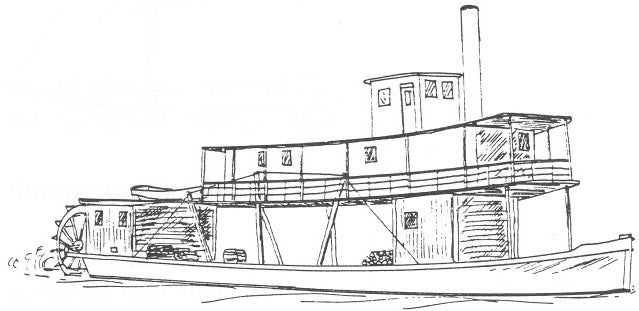
(Alford 1990:35)
Steamboats were used in North Carolina from the 1830s to the 1900s. Traditionally these vessels used large paddles, however, the mid-19th century saw the introduction of the screw propeller. Despite the screw propeller being more efficient, their difficultly to repair saw paddle-driven vessels remain in more isolated rivers. These vessels were used as the workhorse of the area as they were used to carry passengers, deliver mail, goods to plantations and landings, and transported produce to market (Alford 1990:34-35).
The first steamboat entered the Carolinas in 1818 when Norfolk, a steamboat built in Virginia sailed to New Bern, NC. However, it is also possible that an ad from Charleston, SC references the steamboat Enterprise two years prior in 1816. In this early period of steamboats, two distinctive steamboats were being constructed: deep drafted steamers and the smaller, shallow drafted workhorse steamers. The former vessels were common in the North, while the later were common in the South and West. As Earl White points out in his book, there was supposedly a similarity between early Southern and Western steamboats, however, this similarity ended as Western steamboats became much larger than their Southern counterparts. One foreign visitor to the region compared these steamboats to wheelbarrows, on account of them being short and stubby.
The first steamboats in the Carolinas would have been small, noisy, and smoky. These boats would have been so small that they would have towed flats and barges to increase carrying capacity. Towing seems to be more prevalent during the early period of steamboats when side wheels were used. As time went on, stern wheel vessels became more common which allowed for a larger cargo space and more horsepower due to the placement and side of the wheel. To control these vessels, the crews turned a rudder (of on side wheel, adjusted the rotations on each side). Although deep drafted steamers had a draft of five to six feet while the average steamboat in the Carolinas only had a draft around two feet. Despite being steam powered, these vessels were generally slow, only capable of eight knots (some could travel twelve knots but due to the riverine environment was unable to travel this speed).
Since steamboats were used both in a cargo and passenger transportation, the vessels came equipped differently for each task. As a result, some of the vessels had first class state rooms and high quality food such as the Greenville and others had cramped cabins, if they had cabins at all.
Manning these vessels required a large crew, but four roles stood out among the crew of these vessels: the captain, pilot, mate, and engineer. The captain controlled the business end of the ship, from navigation to contracts. Usually, but not always, the captain was the owner or part owner of the steamboat. Alongside the captain would be the pilot, who would be the one controlling the actual navigation of the vessel. Since the pilot who be the one manning the helm, the pilot would need the experience and knowledge needed to read the river for hazards. Since the pilots needed to be experienced, some pilots were freed slaves who had been sailors on plantations before the Civil War. The mate worked on a steamboat and was in charge of the deckhands, management of the cargo, and other general management of the boat. Arguably the most important member of the crew was the engineer. The engineer was trained both in the operation of the steam engine and as a blacksmith that could make parts for the steam engine. Since the engineer only dealt with the steam engine, only the crew members such as the firemen fell under the engineer’s supervision (Alford 1990:34-35; Johnson 1986; Sloan 1971; White 2002).
In North Carolina, two archaeological excavations have taken place on vessels that have been hypothesized to be steamboats: the Old Sparta Wreck and Vessel Four at Castle Island.
In 2008, East Carolina University’s Maritime Studies Program surveyed the remains of a vessel found near Old Sparta, North Carolina. Preliminary surveys and hypotheses on this wreck suggest that the vessel was a barge or other flat bottom boat. However, during 2008 a complete survey and analysis of the site was conducted by Dr. Bradley Rodgers. Through this archaeological examination, it was discovered that the vessel contained materials consistent with the presence of a steam engine. This evidence led the researchers to conclude that the vessel was a steamboat from around the year 1830. Using the historical record it was argued that the vessel may be one of a few steamboats that are known to have sank in the Tar River. The vessel that seems most plausible in the sidewheel steam Tarboro I, which sank around Old Sparta in 1886. Despite being located in the potential area of Tarboro I, discrepancies between the wreck and vessel have appeared, primarily regarding dimensions. The wreck only measures 81 feet long, while Tarboro I is reported to have been 115 feet long. Dr. Rodgers argued that this discrepancy could be the result of the bow of the wreck being missing. The biggest issue however is the beam. The wreck only has a beam of 12.6 feet, while Tarboro I reportedly had a beam of 27 feet. Despite this discrepancy, researchers on the wreck argued that if one were to add the paddle wheels to the wreck an extra 10 feet would be added (5 feet each side) bringing the wreck up to 22.3 feet. The remaining difference was suggested to be found in the flare of the sides of the hull being 2 feet per side adding yet another 4 feet to the wreck. If this is the case, then this vessel could possibly be Tarboro I.
By Caleb O’Brien
